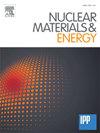焊接速度对核级316H不锈钢激光深熔接头组织及耐蚀性的影响
IF 2.7
2区 物理与天体物理
Q1 NUCLEAR SCIENCE & TECHNOLOGY
引用次数: 0
摘要
采用单道激光自熔焊接核级316H不锈钢板的焊接实验,研究了不同焊接速度下熔池形貌和焊缝耐蚀性的变化规律。结果表明:随着焊接速度的增加,焊缝中δ铁素体含量逐渐降低,焊缝的耐蚀性呈现先升高后降低的趋势;当焊接参数为激光功率9 kW、焊接速度1.6 m/min、离焦量−5 mm时,焊缝抗腐蚀性能最佳。SEM观察表明,焊接速度的提高促进焊缝组织由柱状晶向细小均匀的等轴晶转变,等轴晶的形成显著提高了焊缝的耐蚀性。EDS分析表明,Cr和Mo元素在高温下扩散,在晶界富集,促进铁素体和铁素体的形成。在晶界处,较低的焊接速度促进铁素体形核长大,形成粗铁素体区,而在较高的焊接速度下,快速冷却限制了元素的扩散和铁素体的生成,显微组织倾向于形成细小的等轴晶。XRD分析表明,在低焊接速度下,高的热输入和高温停留时间导致碳作为金属碳化物从FCC晶格中析出,同时,碳化物在晶界处的积累进一步影响了焊缝的微观组织。碳化物进一步影响焊缝的显微组织和耐蚀性。本文章由计算机程序翻译,如有差异,请以英文原文为准。
Effect of welding speed on the microstructure and corrosion resistance of laser deep penetration welded joints of nuclear-grade 316H stainless steel
A single-pass laser self-melting welding of nuclear-grade 316H stainless steel plate welding experiments, the study of different welding speed under the molten pool morphology and weld corrosion resistance of the changing law. The results show that with the increase of welding speed, the δ ferrite content in the weld gradually decreases, and the corrosion resistance of the weld shows a trend of increasing and then decreasing. When the welding parameters are laser power 9 kW, welding speed 1.6 m/min, and out-of-focus amount −5 mm, the weld corrosion resistance is the best.SEM observation shows that the increase of welding speed promotes the transformation of weld organization from columnar crystals to fine and uniform equiaxial crystals, and the formation of equiaxial crystals significantly improves the corrosion resistance of the weld.EDS analysis shows that the elements of Cr and Mo diffuse at high temperatures, enrich in grain boundaries, and promote ferrite and ferrite. at grain boundaries, promoting ferrite nucleation and growth, and forming coarse ferrite regions at lower welding speeds, while at higher welding speeds, rapid cooling limits element diffusion and ferrite generation, and the microstructure prefers the formation of fine equiaxed crystals.XRD analysis shows that high heat input and high temperature residence time at low welding speeds lead to the precipitation of carbon as metal carbides from the FCC lattice, and at the same time, the accumulation of carbides at grain boundaries further affects the microstructure of the weld. Carbides further affect the microstructure and corrosion resistance of the weld.
求助全文
通过发布文献求助,成功后即可免费获取论文全文。
去求助
来源期刊

Nuclear Materials and Energy
Materials Science-Materials Science (miscellaneous)
CiteScore
3.70
自引率
15.40%
发文量
175
审稿时长
20 weeks
期刊介绍:
The open-access journal Nuclear Materials and Energy is devoted to the growing field of research for material application in the production of nuclear energy. Nuclear Materials and Energy publishes original research articles of up to 6 pages in length.
 求助内容:
求助内容: 应助结果提醒方式:
应助结果提醒方式:


